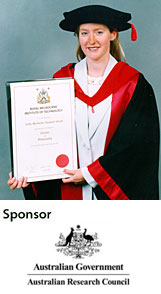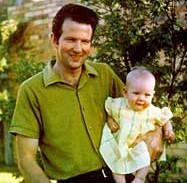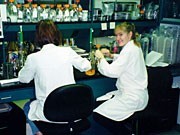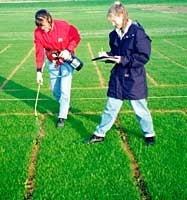Dr Sally Stewart-Wade, plant pathologist

Sally Stewart-Wade was born in 1969 in Melbourne. She completed a Bachelor of Applied Science in Applied Biology (Hons) from the Royal Melbourne Institute of Technology (RMIT) in 1991, for which she studied a fungal disease of the genus Grevillea. She continued on at RMIT and in 1995 completed her PhD on the biological control of the weed thornapple. During her studies she was awarded an Australian postgraduate research award and a Rural Industries Research and Development Corporation scholarship.
In 1994-96 Stewart-Wade worked as a plant pathologist for the then Department of Agriculture, Victoria, where she investigated epidemiological and control aspects of fungal disease of chestnuts. From 1996-1999 Stewart-Wade was at the University of Guelph, in Ontario, Canada, as a postdoctoral fellow. As part of a large collaborative team, she researched biological control methods for broadleaf weeds, in particular dandelions.
In 2000 Stewart-Wade was appointed to her present position as research fellow in the Department of Agriculture and Food Systems in the Institute of Land and Food Resources at the University of Melbourne. She is developing programs for research into diseases of potato and canola. She is also doing some teaching and is involved in management aspects of the department.
Interviewed by Ms Nessy Allen in 2001.
Contents
Introduction
Sally Stewart-Wade is a young scientist already making a major contribution in Australia and overseas to her discipline of plant pathology. She started her career at the Royal Melbourne Institute of Technology, completing a PhD on the biological control of the weed thornapple, using a mycoherbicide approach. From there she joined the Department of Agriculture (now called the Department of Natural Resources and Environment) at Knoxfield as a plant pathologist, studying a fungal disease of chestnuts. She then travelled to the University of Guelph, in Ontario, Canada, as a postdoctoral fellow, and with a large collaborative team investigated biological control agents for broadleaf weeds, in particular fungal pathogens for controlling dandelion. She is now in the Department of Agriculture and Food Systems in the Institute of Land and Food Resources at the University of Melbourne, developing programs for research into diseases of potato and canola.
Family encouragement
Sally, you began your career here in Melbourne. Were you born here?
Yes. After my parents got married, they travelled to Canada for two years and had a bit of an adventure there. They then settled in Melbourne, where they had grown up, and started their family. I came along in September of 1969 as the baby of the family – I've got two older brothers and an older sister. (It was always quite noisy in our household with four kids, so you often had to yell to be heard.)
Did your parents believe in education?
My father was a toolmaker and later a factory manager, and my mother was a secretary who gave up work when they started their family. They both thought that education was very important. They sent my brothers and me to a private school and always were very encouraging, offering to help us with our homework and so on. They were adamant that we got a good education.
My parents didn't particularly push us into science or anything else in particular, but just encouraged us in whatever we wanted to pursue. My brothers did science subjects – the eldest became a surveyor and the other one started as a physics teacher and then became a meteorologist. My sister I think got all the artistic genes of the family; she is more creative, into crafts and things. She is a full-time mother at the moment.
An increasing focus on science
Were you interested in science as a child?
I was. Right from an early age I was always a curious child, asking why things work and how things happen. I guess it began in primary school, when you do little science experiments in the classroom like growing plants in the cupboard without light and others on the shelf with light. I remember having to do a project for show-and-tell. It could be on anything, and I chose to do it on ants – I collected some from the garden and made a little ant farm. In early secondary school I was interested in learning about explorers and astronomers and that kind of thing. Then, towards the end of high school, I did maths, biology and chemistry for my VCE. So I really became very focused on science.
Did your teachers encourage you?
They were always encouraging, but not necessarily to follow science – the encouragement was just to do well at whatever I chose to do. My year 12 chemistry teacher, in particular, suggested that when I finished high school I shouldn't feel that I had to go to a large university and pursue a science degree if I wanted to do something at a smaller college, just as long as I was happy with what I was doing.
I ended up enrolling at the Royal Melbourne Institute of Technology (RMIT) in a Bachelor of Applied Science in Applied Biology, a three-year undergraduate degree. I completed that in 1990.
And then you went on to Honours?
Yes. Realising that with just a degree my job opportunities were limited, I thought, 'Well, I'll do an extra year and see how that goes, and see how I like research.' I decided to stay at RMIT for a one-year Honours year, based on an eight-month research project on a fungal disease of grevilleas. It was essentially finding out more about this fungal complex, which hadn't yet been identified – trying to characterise it and put a name to it.
PhD work in weed control
Did you go straight on to your PhD?
Yes. I enjoyed my Honours year and the independence of the research, so I decided to continue on with a PhD at RMIT. Fortunately, I got an Australian Postgraduate Research Award and that meant that I had a scholarship, some money to live off, to begin my PhD in '92.
I was looking at biological control of the weed thornapple, using a fungus – which is generally seen as an environment-friendly alternative to the usual chemical control. Thornapple is a weed in native vegetation and in horticultural and agricultural crops, and to control it I was looking at the fungus called Alternaria crassa.
I believe that work was so important that it may now be used for commercial purposes.
Yes. Several years later, a company is looking to commercialise the fungus to control the weed thornapple and use it in conjunction with other fungi to control other weeds.
Support funding from scholarships and chestnuts
I understand that you won a postgraduate scholarship during this time.
I did. For the first year I had the research award and then I applied for a Rural Industries Research and Development Corporation scholarship, which was worth more money and was also more prestigious because it was in my subject area. (Only four were given out that year, in an Australia-wide competition.) I was fortunate to be awarded that after quite a heavy interview – there were 12 stern-faced men around the table. At the end of it, when I found that I was successful, they said one of the reasons they gave it to me was my enthusiasm for the subject. It was good to know that, and to have the scholarship for the next two years to support my studies.
Then, while I was finishing my PhD, I had a job with the Department of Agriculture. I worked on an interesting project looking at fungal disease of chestnuts – the epidemiology of the fungus, to find out more about the fungus and how it interacts with its environment; and also control measures to try and stop the rot that the fungus caused in the actual chestnut. I was working full-time during the day and then coming home at night and writing up. I did that for about nine months, and finally got there. One enjoyable part of that job was that most of the fieldwork was in north-eastern Victoria and so I got to travel up to that very nice part of the state for my work.
Collaborating in Canada on broadleaf weed control
You then travelled to Canada. Why was that?
I was enjoying the project at the Department of Agriculture, but I really wanted to continue research into the biological control of weeds, so I applied for a postdoctoral position at the University of Guelph, in Ontario. The job was actually advertised on the internet and I was interviewed by email, which in the mid‑'90s was unusual. I was successful and went to Canada for three years.
This was quite a large collaborative project on biological control of broadleaf weeds, mainly focusing on dandelion. (It was an easy project to explain to people: 'I'm trying to control those weeds in your backyard that have the yellow flowers and the white heads.') There were many groups involved – three university groups, large industry groups, and also a government organisation.
I notice that your publications are all collaborative ones. Do you work in collaboration because your work dictates it, or because you enjoy it?
It's a bit of both. Mostly the work dictates it. It is very rare in my field to have a publication all by yourself – you're usually working in collaboration with others. The increased involvement of industry in science, too, leads to collaborative papers. But at the same time, I enjoy sharing ideas, bouncing ideas off other people.
Does this have something to do with the multidisciplinarity of your subject?
I guess so. I think the best way is to take a holistic, multidisciplinary approach, looking at a problem from all angles. And when you have different people, with different backgrounds and experience, involved in a project, that's when you get some good answers.
After your work in Canada you went travelling for another year.
Yes. I was offered a job in Orange, New South Wales, to work on biological control of weeds after my postdoc dandelion work. It was a very tough decision whether to take that job and come home straightaway, or to travel for a year. But it was only a one-year contract position, without a lot of security, and travelling won out. I thought, 'Well, I'm already halfway round the world. Before I head home, I may as well see some of it.' And I have no regrets at all. I travelled for about five months in North and South America and then about three and a half months in Europe. It was wonderful.
Potato and canola disease research
What are you working on now?
I have two research projects at present. One is in conjunction with scientists at the Institute for Horticultural Development, in the Department of Natural Resources [formerly the Department of Agriculture], where I worked before I went to Canada. We are looking at silver scurf, a fungal blemish disease of potatoes that just causes a mark on their skin but is a big problem in the industry. The project is mainly focusing on finding out more about the fungus and how it spreads from one tuber to another, and also how it survives in the soil or perhaps on other plant material to infect in the next year.
In the other project I am looking at the disease resistance of canola-quality Brassica lines. Brassica species are used to make canola oil and other products, and they are resistant to various fungal diseases, including blackleg (a big industry problem). But the industry is not sure if these Brassica lines are resistant to other fungal diseases such as Sclerotinia stem rot and Alternaria blackspot, both of which are becoming more important. So that is what I am looking at.
Commercial partners in science
Has your work ever been funded by large corporations, such as biotech companies?
There were actually three commercial partners in the project that I was working on in Ontario, the biological control of dandelions. They put in about half the money for the project, and the government of Canada put in the other half. Since I've returned to Melbourne there has been some interest in my PhD work, as I mentioned, so that a commercial sponsor – based in New South Wales – is involved in trying to get the fungus on the market as a product.
A lot of research, especially in my field, is funded by industry, and that's probably going to continue for a while. I guess generally the government has cut back and industry has stepped in, and funding opportunities where you have matching money – half from industry and half from government – are very common.
Does he who pays the piper, call the tune?
Does this influence the type of research you do, and whether you can publish it?
Industry involvement does make a difference to the type of research. If they're providing the money, you can expect them usually to want answers to specific questions, and to a certain extent they do drive the direction of the research project. You have to be able to strike a balance as to how much input they have. As long as you are making sure that the science is good, then that's all that counts.
As to publishing: most of the work I did at the University of Guelph was under confidentiality agreements, because the commercial partners really wanted to get a product on the market, something that they could sell to control dandelions and other broadleaf weeds. Basically you had to keep a secret, which was kind of exciting and you felt you were working on something important. But it did preclude any publications at the time, and that was a bit frustrating. Those confidentiality agreements are just starting to wind down now, so I am able to start to publish some work.
Did it worry you to be working under such conditions?
No, except that it might hurt my career as a scientist, because a good scientist has to publish. But I think that was outweighed at the time by the importance of the work – and I felt that anybody in that field would know that when you have industry partners involved, you often have to work under confidentiality agreements. It's the nature of many aspects of science these days.
Applying pure science insights to real questions
So do you think it is good for science to have industry input?
It's good, in that it keeps science focused on real-world issues. I think the general public have quite a scepticism towards scientists – if they see scientists working on something quite abstract that they don't understand, they lose confidence in them. But if the public can see science working on some real-world issues that require answers, then I think they see that there is value in it.
You are obviously interested in the practical applications of your research.
Yes. I like working on science that asks real questions and needs real answers. Fundamentally there's no difference between pure and applied science – good science is good science. But there is a difference when you are talking about questions and answers. I guess pure research is investigating something for the sake of it, and not necessarily looking for practical outcomes. My work is really more applied research, looking for answers to problems. In pure research, often, you aren't looking for an answer to a question, but the knowledge that you gain from doing pure research does lead to practical applications further on.
The multiskilled scientist
What skills are needed in science these days?
Oh, you have to be multiskilled these days. You have to be very flexible, for one, to be able to adapt techniques for use in different fields, and to adapt yourself as the job market changes and as faculties get restructured – practical things like that. You have to be able to adjust to fit in.
You have to be a very good communicator. You have to be able to communicate not only with your scientific peers but also with industry groups and grower groups such as farmers – and with the general public, again to encourage confidence in science.
As well, you have to be good at handling money, which is something I wish they had taught me in my science degree. You have to be able to manage the research funds that have been allocated to you.
Both a mentee and a teacher
Have you had any mentors?
I guess my main mentor was my senior supervisor for my PhD, Dr Ann Lawrie. She was very hardworking and had a good reputation. And throughout my years at the university, most of the lecturers that I had were very encouraging and you could see that they were hardworking and good scientists. I looked up to them.
Actually, I am now part of a formal mentoring scheme at the University of Melbourne which is trying to get women to progress further in their academic life so that there will be more senior academic women than at the moment. So I am a mentee, and my mentor is a senior lecturer. It is good to have somebody that I can bounce issues off and discuss academic life with.
And you have done some teaching. Did you enjoy that?
I have done just a little bit of teaching – a few guest lectures at this university and the University of Guelph, and also at RMIT when I was doing my PhD. I enjoy teaching, and I'm looking forward to doing some more in the future. Hopefully, I'll get a chance to teach a whole subject, rather than just some guest lectures. It's good to interact with the students, and you always learn something, that's for sure.
Aiming to keep enjoying science
Where do you see yourself in 10 years' time?
I guess I see myself with a research team of my own. I'm quite independent at the moment, in that I don't have any postgraduate students or direct staff working for me as, say, research assistants. I'd like to build up a team of postdoctoral fellows and research associates working closely with me, and have some postgraduate students to supervise and work together on projects. I guess my aim for the future, for 10 years' time, is to be enjoying science as much as I'm enjoying it now.
What kind of research would you like to be doing then?
Well, I'd like to still be in the field of plant pathology. Recently I've become a bit more mainstream – for example, my present potato and canola projects are working on more traditional plant pathology problems – and I've gotten away a little bit from the biological control of weeds, which is more of a fringe area, more daring and revolutionary. I'd like to have a balance between mainstream projects, working on disease problems of horticultural and agricultural commodities (with an applied angle, looking at real problems that need answers) and also some biological control of weeds work, which I think has real potential. There's been a lot of work done just to the point where people have trouble commercialising, say, a fungus to control a weed. I'd like to break through that barrier and actually try to get a product on the market. There have been very few products to date, and that's what I'd really like to work on.
I hope you're successful. Sally, it is clear that you've already made a significant contribution to plant pathology. Thank you very much for participating in this interview, and all the very best in your future career.








